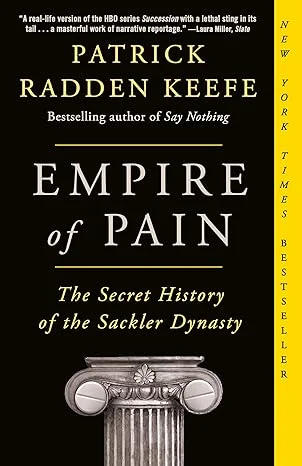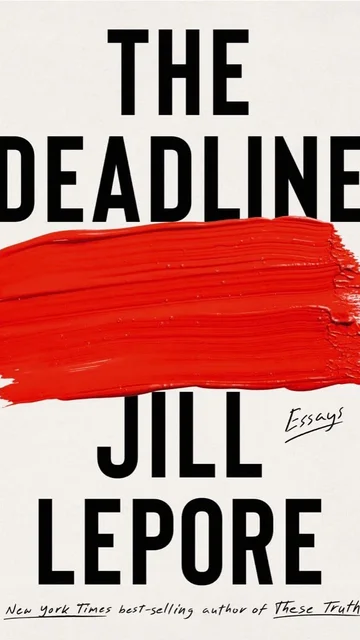
Decades into the opioid epidemic, once-elusive Purdue Pharma and the Sackler family have become household names. Despite their extraordinary efforts to limit the family’s public association with its company, Purdue Pharma, the Sacklers were thrust into the international spotlight as over 1,000 lawsuits amassed against the company between 2007 and 2019 for its role in the surge of opioid misuse and opioid-related deaths since the 1990s. In Empire of Pain: The Secret History of the Sackler Dynasty, journalist Patrick Radden Keefe presents a meticulously researched family history of the Sacklers - and their momentous rise and fall. Unlike much of the other literature on the opioid crisis, Empire of Pain focuses on the family itself, exploring how three generations of Sacklers forged a powerful company with ruthless desire for profit and disregard for the destruction and suffering their drugs caused.
Many people trace the beginning of the opioid epidemic to 1996, the year Purdue Pharma released their patented slow-release version of the semi-synthetic opioid oxycodone, known as OxyContin. While OxyContin’s release was certainly a hinging point for this public health crisis, Keefe expertly chronicles the ways in which early generations of Sacklers built the corporate foundation necessary to market their drugs so aggressively. As early as the 1950s, Arthur Sackler was implicated in a corruption scandal involving the Food and Drug Administration (FDA) and several of the pseudo-scientific journals funded by the pharmaceutical industry, an early warning sign for what was to come. Arthur had two concurrent careers: one as a doctor in a psychiatric research center and the other as a top New York City ad man. He maintained a low professional profile and was able to avoid any accusations of conflicts of interest, even as he fundamentally transformed the pharmaceutical industry with strategies imported from the marketing world. Much of Purdue’s playbook for the rollout of OxyContin came from their experience marketing Valium, another drug with a higher risk of abuse and addiction than the company would admit. What Purdue did with OxyContin did not happen out of nowhere; the Sacklers systematically built Purdue Pharma to be secretive, to have outsized influence over the very government bodies meant to regulate its industry, and to treat medications as no different from any other consumer good to be forcefully marketed to the widest possible audience. In Keefe’s words, Arthur Sackler “created the world in which OxyContin could do what it did.”
Even for those of us who have kept up with the Purdue lawsuits and know the broad strokes of the OxyContin story, the details outlined in Empire of Pain are nothing short of shocking. Keefe presents definitive evidence that executives at Purdue, including several generations of Sacklers, knew exactly how harmful, addictive, and potentially lethal their new medication was. They buried evidence, established inappropriate relationships with government and regulatory officials, and peddled lies. The marketing campaign for OxyContin included a massive sales force of drug reps, who were intentionally sent to target communities in Appalachia and other rural areas with fewer doctors, often places where abuse of prescription drugs was already a problem. At Purdue’s urging, these drug reps encouraged doctors to titrate up their patients’ doses, further putting their patients at risk for misuse and dependence. The drug reps with the highest sales were rewarded with huge bonuses and lavish vacations. In several instances, Purdue was aware that some of the prescribing doctors were diverting the medication to be sold illegally by drug rings, and the company did nothing but sit back and watch their profits soar. As overdose deaths climbed throughout the 2000s, Purdue sank its teeth deeper into its delusional narrative that the problem was not their drug, but the people who abused it. They clung to this narrative even as story after story emerged of people falling into opioid addiction after taking OxyContin exactly as prescribed by their doctors. The level of denial about the reality of the drug and the devastation it inflicted on communities and families across the country is difficult to read. Richard Sackler oversaw the marketing strategy of OxyContin; as late as 2016, he was asking his employees why his news alerts were only showing negative stories about his drug and not telling stories of its success. In 2016 alone, 42,249 people in this country lost their lives from an opioid-related overdose.
Purdue Pharma was never a publicly traded company, and the Sackler family maintained a suffocating grip on its operations from its inception through its bankruptcy in 2019. Among the many cautionary tales in this book, Keefe highlights the true dangers of a corporate world in which family loyalty - and profit - are valued over constructive disagreement and a welcoming of external opinions. The Sacklers wanted to be surrounded by yes men, whether they were family members or people who pledged their loyalty to the family at whatever cost. One of the most disturbing details of the book is the sheer amount of people who continued to echo the lies and delusions about OxyContin and revere its makers and marketers, even as evidence amassed that people were suffering and dying.
Though much of the human suffering exists in between the lines of Empire of Pain (unlike many of the other popular books and films on the subject), the book is difficult to read. It is challenging to imagine a family so corrupted by money, so ruthless, and so willing and able to dismiss mountains of scientific and anecdotal evidence. It is difficult to come to terms with a system in which prescription medications are marketed with the same techniques used to market televisions, candy bars, or iPhones, or with a system in which the pharmaceutical industry still wields tremendous power over our elected officials and nonpartisan regulatory agencies. It’s difficult to think about the thousands of lives turned upside down, or ultimately ended too soon, by a medication they were told was safe by medical professionals they trusted. But this is a story we all must confront and know and share. Though we’ve now entered a new phase of the opioid crisis, one dominated not by prescription drugs but by counterfeit synthetics like fentanyl, it is absolutely essential that we understand how we got where we are and who is responsible. Empire of Pain is, in a word, a must-read.
 Skip to main content
Skip to main content


